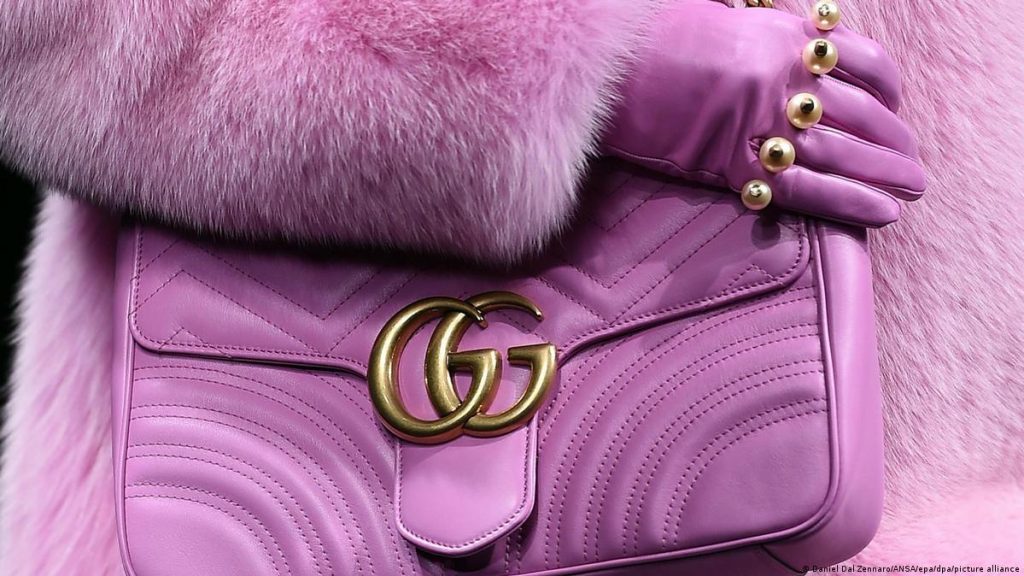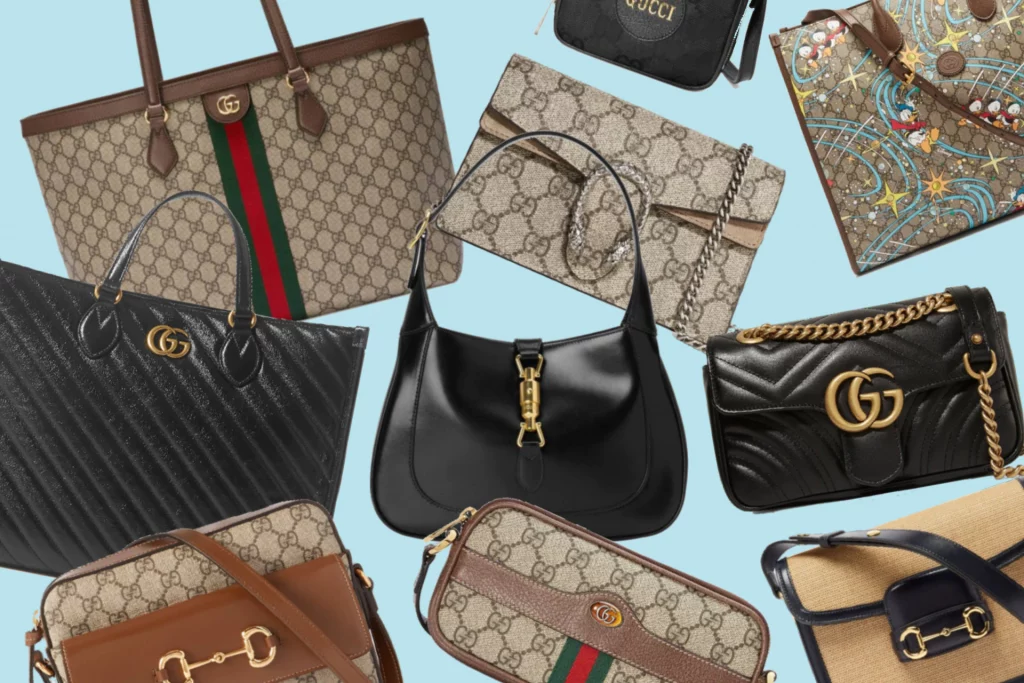The Marketing mix of Gucci analyses the 4Ps of Gucci, including the Product, Price, Place, and Promotions. Gucci Marketing Mix gives high importance to product placement, product portfolio, pricing strategy, promotional activities, and physical evidence of the Gucci brand. Owning Gucci products and other accessories is a status symbol, so buyers are ready to purchase from the premium brand.
An essential aspect of the Gucci marketing strategy is maintaining the visually appealing look of the company in the target market. The marketing objectives behind the Gucci marketing mix framework are to maintain its high status, connect with Gucci’s customers, and achieve business goals.
Table of Contents
Introduction of Gucci
#Gucci
- Origin Country: Italy
- Founder: Guccio Gucci
- Previous Creative Director: Alessandro Michele
- Current Creative Director: Sabato de Samo
- Parent: Kering
- Founded: 1921
- Headquarters: Florence, Tuscany, Italy
- Brand Value in 2023: 18.1 billion USD
The Italian fashion brand Gucci from Guccio Gucci is one of the most coveted luxury brands in the world. The brand name is synonymous with high-end quality, a status symbol for women, and an exorbitant price tag. If one is to describe the company, the words that come to mind are innovative and influential, as the luxury brand has reinforced its position in the global fashion industry as one of the most desirable fashion houses.
The product offerings and services provided by the luxury brand are unsurpassed for both quality and attention to minute details. Gucci’s full product line and portfolio is Italian craftsmanship at its best, so the company is a hit amongst its target audience.
Gucci Product Strategy
Gucci started its journey as a leather goods manufacturer, becoming one of the most prestigious luxury fashion brands worldwide. The Italian fashion brand is a significant personal luxury goods market player. One-third of its market value is because of sales of other accessories like handbags and luxury watches.
The Gucci framework has positioned the brand products at the top because of product innovation, premium design, and quality materials. With the help of Gucci’s marketing strategy, the brand has ensured that Gucci products appear extremely expensive and superior to the customers; it will help maintain the tag of a visually appealing premium brand in the fashion world.
As of 2024, Gucci’s product mix is expansive and diverse, reflecting its established status as a premier luxury fashion brand.
The new Product Mix of Gucci in 2023 is as follows (Source).
- Handbags: Various bags, such as shoulder bags, mini bags, top handle bags, clutches, belt bags, everyday bags, and tote bags, are renowned for their craftsmanship and design.
- Travel Accessories: This category includes travel bags, trolleys, travel accessories, and hard-sided luggage.
- Ready-to-Wear Clothing: Gucci offers a wide range of clothing, including outerwear, knitwear, skirts, activewear, denim, swimwear, etc.
- Footwear: A comprehensive collection of boots, ballet flats, sneakers, mules, loafers, pumps, sandals, and dress shoes.
- Accessories: Wallets, pouches, card holders, belts, hats, jewelry, socks, tights, scarves, eyewear, and more.
- Home Decor: Items like furniture, wallpaper, textiles, home accessories, and tableware.
- Lifestyle Products: This includes loungewear, sporting goods, leisure pieces, and stationery.
- Pet Collection: Comprising pet homeware, pet clothes, and pet accessories.
- Beauty Products: A selection of cosmetics and fragrances, including lipsticks, eyeliner, blush, nail polish, and foundation.
Gucci Place Strategy
Gucci’s marketing mix and distribution strategies greatly emphasize the place mix. The company has spread its product presence to an estimated 501 retail or specialty stores globally. It operates in the United States of America, Australia, Europe, Asia, and the Middle East.
Gucci’s place strategy is characterized by its focus on exclusivity and accessibility in the luxury market:
- Global Retail Network: Gucci maintains an extensive global presence with 501 specialty stores worldwide, ensuring accessibility to its luxury products across various continents.
- High-End Store Locations: The brand strategically places its boutiques in upscale, high-traffic areas to attract an elite clientele.
- Direct Sales and Personalized Service: Gucci emphasizes direct sales in their boutiques, providing personalized service to enhance customer experience.
- Online Sales Platforms: They have robust online sales channels, making their products available in 25+ markets through their own and third-party e-commerce platforms.
- Efficient Distribution and Inventory Management: Gucci utilizes automated systems for efficient inventory management and relies on both in-house and third-party transportation for product delivery.
Gucci Pricing Strategy
As a significant chunk of revenues is derived from leather goods, followed by shoes and then ready-to-wear clothing, Gucci’s marketing mix focuses on its product portfolio to a great extent to capture the target market. The product offerings are categorized according to raw materials used, Gucci’s customers, competitors, and sales figures, and a suitable pricing strategy is decided upon.
As Gucci is one of the industry’s top luxury fashion brands, the raw materials used are of top quality. Moreover, the work done on the fabrics also makes high-quality products, increasing overall costs and high prices.
Gucci’s pricing strategy is meticulously designed to uphold its status as a luxury brand:
- Premium Pricing Strategy: Gucci employs a premium pricing model, aligning its prices with the brand’s high-quality and luxury status.
- Psychological Pricing Approach: The brand leverages psychological pricing, where high prices are associated with superior quality, catering to consumers who equate price with value.
- Selective Discounting for Market Penetration: Gucci occasionally implements discount strategies to attract a younger demographic, offering quality products at more accessible prices during these periods.
Gucci Promotion Strategy
The promotional strategies in Gucci’s marketing mix focus on digital marketing and social media marketing by using various social media platforms, fashion shows from creative designers, traditional media advertising strategy, and up-to-the-mark packaging.
In recent years, the creative director and designer Alessandro Michele has been fully involved in the company’s advertising strategy and driving the advertisements and digital marketing campaigns forward. He has been credited with making Gucci one of the most treasured luxury brands of its times.
Traditional Media
Gucci’s advertising strategy focuses on promotion and advertising through traditional media, such as advertisements in high-end fashion magazines, billboards, and banners. Gucci also uses digital marketing campaigns to boost its brand visibility. Although Gucci has recently launched several TV advertisements, the brand prefers to use print media rather than TV advertisements in most cases.
Social Media Marketing
Social media is one of the best brand advertising tools in the current era. Gucci advertisements and digital marketing campaigns feature on social media platforms like Tumblr, Instagram, YouTube, Pinterest, and Facebook.
As part of Gucci’s marketing strategy, various bloggers have been hired for brand advertising and promoting content through their social media pages and various social media platforms. The Gucci Style App launched by Gucci in eight languages includes interactive videos, Geo location tips, fashion, etc.
Image-driven Content
The advertising strategy has helped the company to please consumers and establish its dominance as one of the iconic luxury brands in the industry. Advertisements are Gucci’s forte, and the brand has published visually rich content featuring Gucci’s campaigns and collections on its website.
Website Redesign and Relaunch
As part of its advertising strategy, Gucci ensures that all online stores offer a unique experience to the customers. The ready-to-wear collections are curated as they appear on the runway fashion shows. Gucci has a customer service option on every product page of its website, so interested customers can contact salespersons if needed.
Gucci and Celebrities: Gucci’s Marketing Strategy
As part of its advertising strategy, Gucci has collaborated with Lady Gaga, who sang the National Anthem at Super Bowl 2016 wearing Gucci suit pants designed by creative director Alessandro Michele. Gucci has also collaborated with Harry Styles, Grace Kelly, and Tom Ford.
At the BRIT Awards, Harry Styles stole the show with his vintage Gucci Look and managed to grab everyone’s attention. It was Grace Kelly who inspired the signature Gucci floral print everyone loves. Who can forget the Tom Ford era, which saw Gucci as an unbuttoned button-down in various fashion shows?
Adidas and Gucci’s collaboration resulted in some of the best releases and signature athlete silhouettes.
Sustainability and Gucci
Gucci’s marketing mix focuses on the company’s commitment to sustainable efforts as part of its promotional strategies. It has developed low-impact materials and eco-friendly sourcing solutions to protect nature. For product packaging, Gucci uses a green color that will reduce the use of inks and is crafted from sustainably managed forest resources. Gucci has also eliminated the use of plastic in product shipment.
Memorable Marketing Campaigns: Gucci Marketing Strategy
Some of the memorable digital marketing campaigns in the marketing strategy of Gucci include.
GG Marmont Collection
“GG Marmont Collection,” lensed by Dazed, has Daisy Edgar-Jones appearing in the ad campaign.
GUCCI 25H
In the “GUCCI 25H” campaign, Jessica Chastain muses over the concept of time.
Gucci Valigeria
Ryan Gosling was roped in to appear in the “Gucci Valigeria” campaign that reflects the brand’s vision of travel.
Some Recent Video ads and Print ads for Gucci are:
Liked this post? Check out the complete series on Marketing Mix

